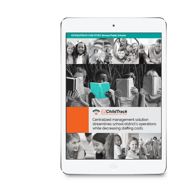
Before welcoming students back to school, educators must take time to review, plan, and implement policies to account for the “new normal.” Pay particular attention to local health and government resources and guidelines and be prepared for rapid change.
In fact, make the potential for change part of every policy moving forward. Here are a few policy considerations.
School Closure and Dismissal Decision Policy
The CDC released a chart of recommendations for various levels of community virus spread.
Your policy should address the following policies and planning.:
- School regardless of community spread.
- School if there is no community spread.
- School during minimal or moderate community spread.
- School during substantial community spread.
What to do if a person with confirmed COVID-19 is in the building is a critical policy to implement. Include how you intend to assess risk and handle closures for cleaning and disinfecting. Include a process for contact tracing in consultation with local health officials.
Planning and Preparing
Each year, reviewing policies and processes is part of the best practices for running a school or other childcare situations. This year, it's particularly important to ensure your policies address issues brought to the fore during the pandemic.
- Review, update, and implement your emergency operations plans in collaboration with your local health authorities and partners. Emphasize everyday preventative activities and reference key resources.
- Develop an information system with your partners.
Review and update rules about absenteeism, class sizes, and how classes will meet. - Establish procedures for students and staff who become ill at school.
- Create and test a communication plan for the school community.
- Review CDC guidelines for businesses and employees for developing policies for teachers, staff, and other personnel.
Build in flexibility to respond to rapid changes in guidance or the school environment throughout the school year.
School Operations
Now is the time to review and update your cleaning and disinfection schedules and guidelines. You want to reassure parents that you are maintaining a safe environment for their children.
- Consider closing certain spaces such as the playground and discontinuing the practice of sharing supplies.
- Decide your policy on-campus visitors. Who is allowed to enter the school? What must that individual do to enter and interact?
- What is your policy on personal protective equipment (PPE)? Who will supply it, and how will it be maintained?
- Decide how to serve meals. A standard recommendation is to serve meals in the classroom instead of gathering in the cafeteria.
- Transportation, in particular busing, policy must address the need for screening, physical distancing, and mask-wearing.
COVID-19 touches every area of operations in one way or another. Work with department heads, janitorial services, and others to finalize the policies.
Health, Social, and Emotional Needs
Depending on your location, you may need to address a broad range of student needs. Mental health support is particularly crucial with the disruptions to modern life. If you offer extracurricular activities such as sports and music, allot additional time to consider whether to continue to provide them and how to do so safely.
Think about the need for additional counselors, nurses, social workers, and other support staff. While considering your staffing and personnel, how will you address those individuals who are at higher risk of a poor outcome if they become infected with COVID-19? Do you need to reconsider your requirements for certification and training?
Academics
Continuity of learning is on everyone’s mind. Your policies must address schedules and learning time, whether in person or virtually. If you must provide distance learning, do you have students with connectivity or technology issues?
Create a process for rapidly pivoting from face-to-face learning and online learning, and test the system before school begins to ensure a smooth change-over if needed.
Coordinate with health officials, staff, parents, and students to address outstanding concerns and provide a welcome back for students this fall.




